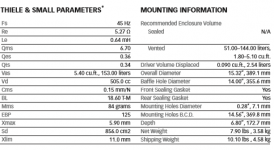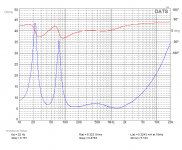I picked up this system a couple of days ago and ran a few tests. First, I ran the impedance sweep and TS parameters for my 2x3015 bass guitar cab and found that the measured response matched the model simulated by .950 Winisd. So that was good.
I ran free air and vas tests for one of the two drivers and came up with some pretty pronounced deviation from factory data sheet. (1 and 2)
Although BL is pretty much bang on. But Vas is way higher and Re is a bit higher.
And then ran tests in cab for my 15/6 cab details of which are in my post 15/6 bass cab design. (thumb 3)
I have a couple of questions:
Is it possible for sustained periods of heavy use to impact the FA parameters like this? Or do I have a problem?
In the third thumb, 15.6 DATS, it says the Re is 6.323 ohms. What does this mean?
From this data on the 15.6, what would you say the nominal impedance of this cab is?
Thanks in advance for any/all the help.
I ran free air and vas tests for one of the two drivers and came up with some pretty pronounced deviation from factory data sheet. (1 and 2)
Although BL is pretty much bang on. But Vas is way higher and Re is a bit higher.
And then ran tests in cab for my 15/6 cab details of which are in my post 15/6 bass cab design. (thumb 3)
I have a couple of questions:
Is it possible for sustained periods of heavy use to impact the FA parameters like this? Or do I have a problem?
In the third thumb, 15.6 DATS, it says the Re is 6.323 ohms. What does this mean?
From this data on the 15.6, what would you say the nominal impedance of this cab is?
Thanks in advance for any/all the help.
Attachments
Last edited:
DATS v2 here. Eminence Delta 10A also measures with a much higher VAS, lower FS (57hz rather than 66), slightly higher Qms, but RE is only a fraction higher. Qes is spot on.
Driver TS Parameters: Cms (Compliance) & Vas (Compliance Equivalent Volume) >> speakerwizard.co.uk
Vas is is proportional to suspension compliance which is a very hard parameter to control and varies a lot with temperature. Try doing the measurements at different temperatures and you will see.
Vas is is proportional to suspension compliance which is a very hard parameter to control and varies a lot with temperature. Try doing the measurements at different temperatures and you will see.
Thanks everybody.
Any comment on the last 2 questions? -
IE - what does dats mean when it says the loudspeaker re is 6.323 ohms, and
What would you say the nominal impedance of this loudspeaker is?
Note - Minimum impedance measures ~ 5.4 ohms at 1358 Hz
Any comment on the last 2 questions? -
IE - what does dats mean when it says the loudspeaker re is 6.323 ohms, and
What would you say the nominal impedance of this loudspeaker is?
Note - Minimum impedance measures ~ 5.4 ohms at 1358 Hz
Hello Earl and thanks for your reply.
I'm afraid I don't understand what the graph says however and have to ask specifically what it means.
If there is some context for example a webpage this graph wasposted on that might be helpful.
Thanks!
I'm afraid I don't understand what the graph says however and have to ask specifically what it means.
If there is some context for example a webpage this graph wasposted on that might be helpful.
Thanks!
Gord,
It's the AC curve that matters ( for everything but "naming" conventions ).
- IOW; don't fixate on labels .
That AC curve ( as an .ZMA file ) is used within crossover simulators.
The pic comes from Wikipedia ( Nominal Impedance ).
🙂
It's the AC curve that matters ( for everything but "naming" conventions ).
- IOW; don't fixate on labels .
That AC curve ( as an .ZMA file ) is used within crossover simulators.
The pic comes from Wikipedia ( Nominal Impedance ).
🙂
Re represents the resistance of the voice coil. Resistance is one of the three components that can make up an impedance.
Thanks Allen. Please note this is a two way speaker with a 1st order low pass and zobel on the woofer and 2nd order high pass on the midrange.
It's my attempt at a bass cabinet.
It's my attempt at a bass cabinet.
Re represents the resistance of the voice coil. Resistance is one of the three components that can make up an impedance.
Is it not fourth components; resistance, inductance, capacitance and frequency?
Is it not fourth components; resistance, inductance, capacitance and frequency?
One could argue the semantics either way... I think it is correct to say that impedance of speaker driver changes with frequency... and at a given frequency, impedance is made up of resistance, inductance, and capacitance.
Yes. One could also say magnitude, phase and frequency, or they could say real, imaginary and frequency..
Interesting
This is really good information.
A guy could get paralyzed with indecision because things aren't "ideal" or "perfect".
Ultimately, I gotta melt some solder and make some sawdust.
"Damn the torpedoes, and full speed ahead!"
DATS v2 here. Eminence Delta 10A also measures with a much higher VAS, lower FS (57hz rather than 66), slightly higher Qms, but RE is only a fraction higher. Qes is spot on.
This is really good information.
A guy could get paralyzed with indecision because things aren't "ideal" or "perfect".
Ultimately, I gotta melt some solder and make some sawdust.
"Damn the torpedoes, and full speed ahead!"
- Home
- Loudspeakers
- Multi-Way
- Picked up a DATS V3



